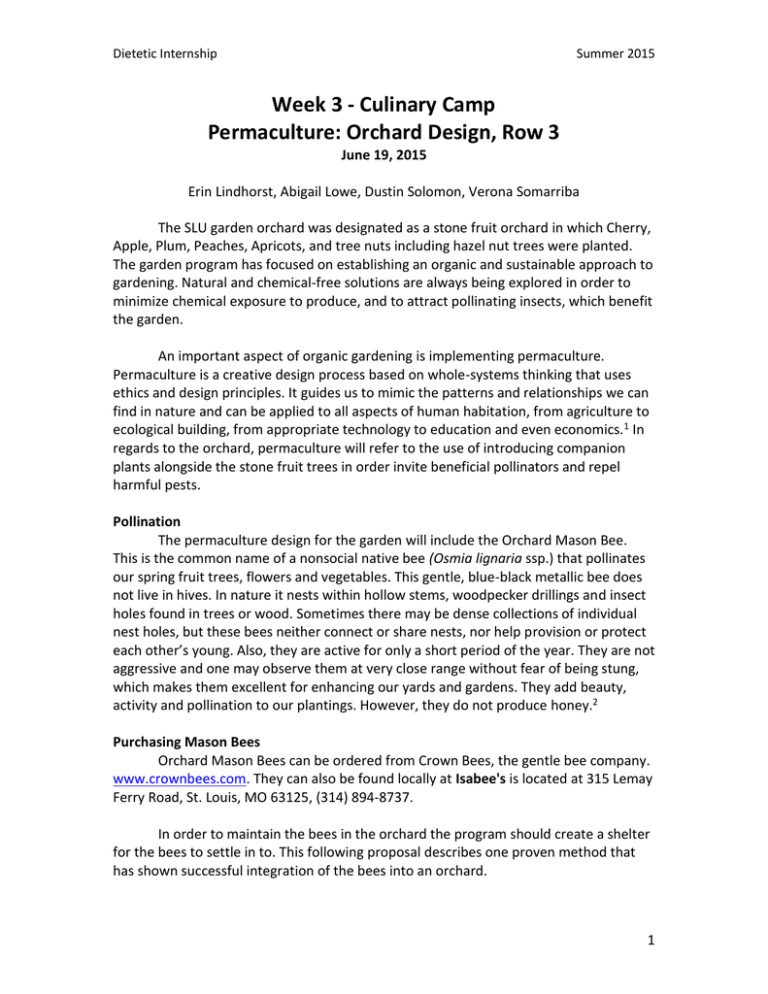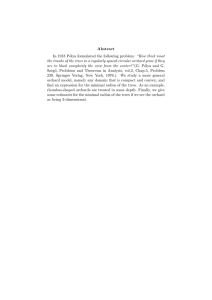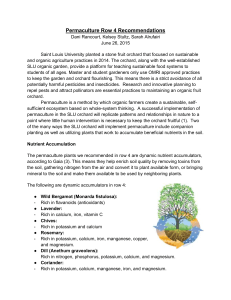Permaculture- Week 3 Row 3
advertisement

Dietetic Internship Summer 2015 Week 3 - Culinary Camp Permaculture: Orchard Design, Row 3 June 19, 2015 Erin Lindhorst, Abigail Lowe, Dustin Solomon, Verona Somarriba The SLU garden orchard was designated as a stone fruit orchard in which Cherry, Apple, Plum, Peaches, Apricots, and tree nuts including hazel nut trees were planted. The garden program has focused on establishing an organic and sustainable approach to gardening. Natural and chemical-free solutions are always being explored in order to minimize chemical exposure to produce, and to attract pollinating insects, which benefit the garden. An important aspect of organic gardening is implementing permaculture. Permaculture is a creative design process based on whole-systems thinking that uses ethics and design principles. It guides us to mimic the patterns and relationships we can find in nature and can be applied to all aspects of human habitation, from agriculture to ecological building, from appropriate technology to education and even economics.1 In regards to the orchard, permaculture will refer to the use of introducing companion plants alongside the stone fruit trees in order invite beneficial pollinators and repel harmful pests. Pollination The permaculture design for the garden will include the Orchard Mason Bee. This is the common name of a nonsocial native bee (Osmia lignaria ssp.) that pollinates our spring fruit trees, flowers and vegetables. This gentle, blue-black metallic bee does not live in hives. In nature it nests within hollow stems, woodpecker drillings and insect holes found in trees or wood. Sometimes there may be dense collections of individual nest holes, but these bees neither connect or share nests, nor help provision or protect each other’s young. Also, they are active for only a short period of the year. They are not aggressive and one may observe them at very close range without fear of being stung, which makes them excellent for enhancing our yards and gardens. They add beauty, activity and pollination to our plantings. However, they do not produce honey.2 Purchasing Mason Bees Orchard Mason Bees can be ordered from Crown Bees, the gentle bee company. www.crownbees.com. They can also be found locally at Isabee's is located at 315 Lemay Ferry Road, St. Louis, MO 63125, (314) 894-8737. In order to maintain the bees in the orchard the program should create a shelter for the bees to settle in to. This following proposal describes one proven method that has shown successful integration of the bees into an orchard. 1 Dietetic Internship Summer 2015 Mason Bee Proposal Function: Help pollinate plums, cherries, apricots, nectarines, apples, peaches, pears, kiwis, blueberries, walnuts, hazelnuts. Annual will have more seeds to reproduce for the following year. Facts: Each female owns her own hole: will gather pollen and nectar, lay an egg, and then seal that chamber with gathered mud. Supplies: Spring pollen for food: from fruit trees, most spring perennials. HOUSING: o House placement: on a sunny warm morning wall and under an overhang if possible, and about 5-6 feet above ground. Mud nearby o Fall cocoon harvest: Collect the nests in the fall to reduce the pests. o Supplies: Use EasyTear Tubes or Reeds Wooden house or structure. House should slope downward to allow water to drain. o Directions: Pick a structure either a wood box, or pot or other hollow structure. Fill with reeds or easy tear tubes: these should have an overhand of 2-3 inches. Between some tubes place sticks to create space. Place Bee attractant (such as blue cloth). Find a location to hang where house can slope slightly downward to allow water to drain. Mason Bees: o About 5-7 nesting females can pollinate one blossoming fruits.3 2 Dietetic Internship Summer 2015 Examples of Mason Bee Houses: Stone fruit trees are prone to a variety of pest which include: Oriental Fruit Moths Plum Curculio Peachtree Borers Cherry Fruit Flies Peach Silver Mites Green June Beetle Drought Drowning and Edema Companion plants are an aspect of permaculture which are meant to compliment these trees by attracting friends and repelling foes in a sustainable manner. These companion plants will also ensure that no unwanted harmful weeds grow around the trees and crowd the root, which would deprive the tree of much needed oxygen. 3 Dietetic Internship Summer 2015 Recommendations Stone Fruit Tree and Nut Tree Companion Plants 1 2 4 5 3 6 9 8 7 1.Daffodils, 2. Comfrey, 3. Borage, 4. Lilac Bushes, 5. Lavender, 6. Southernwood, 7. Marigold, 8. Horseradish, 9. Buddleia (Butterfly Bush) Daffodils: This plant is often referred to Narcissus, named after a mythological boy who loved to admire his own beauty. The daffodil consists of two parts, the perianth (petal) and the corona (the cup). This plant should be placed in the ground in late fall before the first frost. The cold temperature promotes proper root development. Comfrey: Considered a “dynamic accumulator,” comfrey has deep tap roots that mine the subsoil for minerals which it makes available to the tree when its leaves die or are slashed periodically throughout the growing season. Comfrey is a “must-have” for every permaculture garden or orchard. It is useful for herbal salves, a wonderful high-protein animal fodder, and attracts beneficial insects. Its leaves are high in nitrogen, and it is used by many organic gardeners 4 Dietetic Internship Summer 2015 as a compost activator. Planted in a ring around a young fruit tree, comfrey grows vigorously, spreads by clumping out and keeps out weeds when full sun is available under the tree (a living mulch). It will gradually die back as the tree gets bigger and casts more shade. Borage: This plant, also known as the starflower, is one of the best plants to attract pollinators. The use of the Borage is to repel harmful insects, attract pollinators, and help to increase resistance to pests and disease. Persian Lilac Bushes: The lilac shrub is a native plant to the olive family. These plants come in many colors and are excellent pollinator attractors. This type of lilas was selected for its typical height for it’s maximum height of four feet, which will compliment the trees very nicely. Lavender: A flowering plant in the mint family. Lavender is useful around fruit tress due to its repellant qualities, many insects and animals find it repulsive. Lavender will also benefit many other plants due to its ability to attract pollinators. 9 Southern Wood: A flowering plant native to Europe. Southern wood is beneficial for fruit trees due to its ability to repel fruit tree moths when grown in a orchard. African Marigolds: A bright orange flower that provides a natural pest deterrent. Marigolds have traditionally been used to deter beetles, rabbits and other harmful insects or pests. Horseradish: This plant is part of the perennial family and will not be harvested, it will be used as a perennial. When this plant is in the ground, it produces no odor, but when harvested and cut in to it puts off an irritating odor. This plant is especially helpful to cherry trees and has minimal maintenance. It dredges subsoil minerals from the soil making them available for uptake by the fruit trees.5 Buddleia: summer lilac/butterfly bush, attracts hummingbirds, attracts beneficials, deer resistant. The butterfly bush as aptly named. It is a magnet for butterflies, hummingbirds and all sorts of beneficial insects that flock to this plant in late summer and fall when it’s in full bloom. This sun-lover provides great color and stature in the garden often growing from ground level to up to 8 feet tall in one growing season. All recommended plants can be planted within the same row, without having any allopathic reactions. 5 Dietetic Internship Summer 2015 * 13 * 14 * 15 * 16 * 17 * 18 * 19 * Comfrey Hazelnut Tree Southernwood Asian Pear Tree Horseradish Hazelnut Tree Southernwood Peach Tree Persian Lilac bushes Reliance Peach Tree Borage Redhaven Peach Tree Lavender Proposal: Asian Pear Budelia Design Plan for implementing both permaculture in Row 3 of SLU garden Orchard. * Bracket the row with African Marigolds and Zinnia References 1. Permaculture Principles. http://permacultureprinciples.com 2. Mason Bee Houses. http://www.mclendons.com/files/u1/An-Intuitive-Guide-tothe-Gentle-Mason-Bee.pdf 3. Ornamentals and Turf. http://www.ces.ncsu.edu/depts/ent/notes/Other/note109/note109.html 4. Stallings, Ben. "Does Comfrey Really Improve Soil?". Permaculture News. Permaculture Research Institute. Retrieved 27 June 2014. 5. Plant Guilds. https://midwestpermaculture.com/eBook/Plant%20Guilds%20eBooklet%20%20Midwest%20Permaculture 6. Philips, Michael. The Holistic Orchard: Tree Fruits and Berries the Biological Way 7. Green C, Hemenway T. Gaia’s Garden. Chelsea Green Publishing, White River Junction Vermont. 2009. 8. St. Louis Audobon Society. Bring Conservative Home, Site Visit Report. NonNative Invasive Plants, Naturescaping. August 2, 2013. 9. University of Missouri Extension. http://extension.missouri.edu/p/G6830 6

